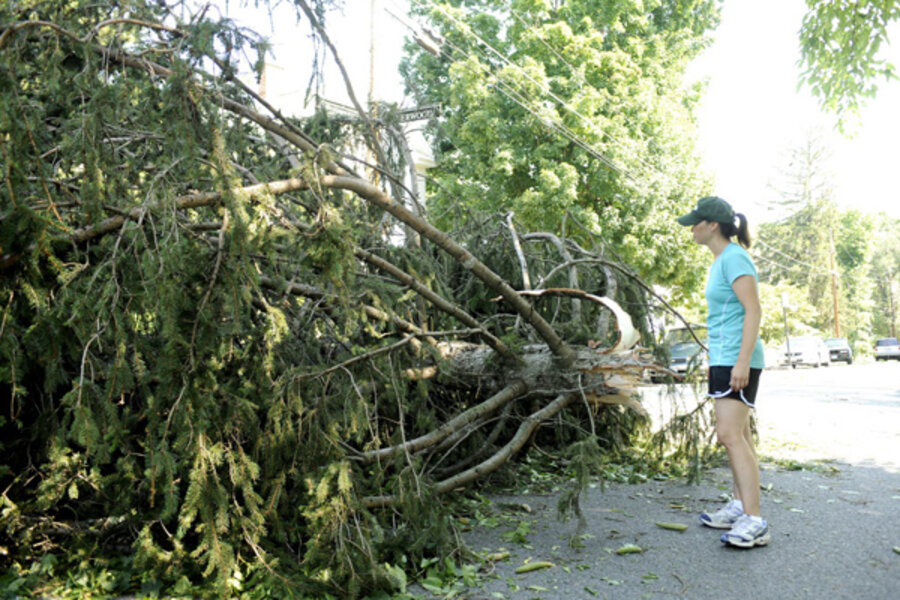As utility crews scramble, 1.4 million remain without power after storm
Loading...
| WASHINGTON
Utility crews struggled to catch up with a backlog of millions of people without electricity for a fourth hot day Tuesday as frustration grew and authorities feared the toll of 22 storm deaths could rise because of stifling conditions and generator fumes.
Power was back for more than a million customers but lights— and air-conditioning — were still out for about 1.4 million homes and businesses in seven states and the District of Columbia. The damage was done bypowerful wind storms that swept from the Midwest to the Mid-Atlantic late Friday, toppling trees and branches into power lines and knocking out big transmission towers and electrical substations.
Utilities were warning that many neighborhoods could remain in the dark for much of the week, if not beyond. Public officials and residents were growing impatient.
"This has happened time after time and year after year, and it seems as if they're always unprepared," said John Murphy, a professional chauffeur from Burtonsville, Md., who was waiting for Pepco to restore powerMonday to the homes of himself and his mother and sister, who live nearby.
The wave of late Friday evening storms, called a derecho, moved quickly across the region with little warning. The straight-line winds were just as destructive as any hurricane — but when a tropical system strikes, officials usually have several days to get extra personnel in place.
So utility companies had to wait days for extra crews traveling from as far away as Quebec and Oklahoma. And workers found that the toppled trees and power lines often entangled broken equipment in debris that had to be removed before workers could even get started.
Adding to the urgency of the repairs are the sick and elderly, who are especially vulnerable without air conditioning in the sweltering triple-digit heat. Many sought refuge in hotels or basements.
Officials feared the death toll, already at 22, could climb because of the heat and widespread use of generators, which emit fumes that can be dangerous in enclosed spaces.
After Maryland reported Monday that three people had died in the recent heat wave — the deaths were not storm-related — Deputy Secretary Fran Phillips stressed that people who are in areas without power need to take advantage of cooling centers.
At the Springvale Terrace nursing home and senior center in Silver Spring, Md., generators were brought in to provide electricity, and air-conditioning units were installed in windows in large common rooms to offer respite from the heat and darkness.
Residents using walkers struggled to navigate doors that were supposed to open automatically. Nurses had to throw out spoiled food, sometimes over the loud objections of residents.
The lack of power completely upended many daily routines. Supermarkets struggled to keep groceries from going bad. People on perishable medication called pharmacies to see how long their medicine would keep. In Washington, officials set up collection sites for people to drop off rotting food. Others held weekend cookouts in an attempt to use their food while it lasted. And in West Virginia, National Guard troops handed out food and water and made door-to-door checks.
When it comes to getting the power running again, all utilities take a top-down approach that seeks to get the largest number of people back online as quickly as possible.
First, crews repair substations that send power to thousands of homes and businesses. Next, they fix distribution lines. Last are the transformers that can restore power to a few customers at a time.
Some people said the destruction over the weekend was reminiscent of that caused by Tropical Storm Isabel in 2003 and Hurricane Irene in 2011.
Last year, it took Baltimore Gas and Electric company eight and a half days to restore service to all 750,000 customers who lost power during Hurricane Irene. This time, the power company initially confronted more than 600,000 people without power. It said restoration efforts will extend into the weekend.
Baltimore Gas and Electric said in a letter posted on its website that it would take hundreds of thousands of man-hours to clear debris and work through outages. Crews were working around the clock in 16-hour shifts.
"This type of widespread, extensive damage also complicates our ability to quickly provide accurate restoration times, especially when original damage assessments are revised upon closer inspection of the work required," the letter said.
However, Maryland Gov. Martin O'Malley has been blunt that the utilities must work faster: "No one will have his boot further up Pepco's and BGE's backsides than I will," O'Malley said Sunday.
In Baltimore County, Eveena Felder, a registered nurse, had been relying on air-conditioned public areas to keep cool during the day and a fan to help her family sleep.
"We've purchased a ton of batteries, that's where most of our money has gone," Felder said. "Turn the fan on and keep still, don't move, less energy."







